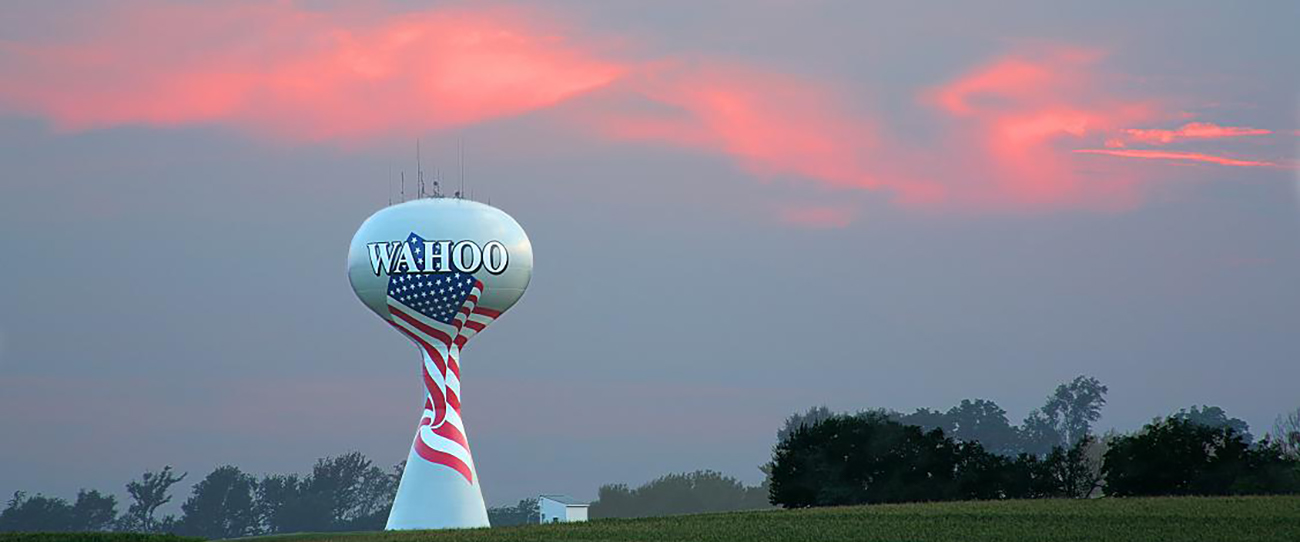History
Wahoo, from an Indian word meaning "burning bush", was founded in 1870 by a group of settlers who believed this area would become one of the richest farming regions in the state. Through hard work, determination, and ingenuity, these predominately Czech, German, and Scandinavian settlers turned their dreams into reality.
Five Famous Sons
Any town in America would be proud of Wahoo's honor roll of native sons: Baseball Hall-of-Famer, Samuel "Wahoo Sam" Crawford; Pulitzer Prize winner, Dr. Howard Hanson; artist and author, Clarence W. "Herk" Anderson; Nobel Prize winner, Dr. George Beadle; and movie maker, Darryl F. Zanuck.
"Wahoo Sam" Crawford
Sam Crawford was born on April 18, 1880, and grew up playing baseball on the streets in Wahoo. After his seventh year of school, he began working for a local baseball sponsor who took teams to surrounding towns for games.
At age 19, he began his career with the major leagues. He joined the Tigers in 1903 where he spent his remaining major league career. After that, he began coaching college teams. "Wahoo Sam" was inducted into the Hall of Fame in 1957.
Wahoo residents were saddened by his death on June 15, 1968, for they had been as proud of him as he was of his birthplace.
Dr. Howard Hanson
Composer, conductor, author, educator, and Pulitzer Prize winner, Howard Hanson was born October 28, 1896, of second-generation Swedish-Americans in Wahoo.
He became the first American to win the prestigious musical competition Priz de Rome. He headed the Eastman School of Music at the University of Rochester in New York, and in 1944 he was awarded a Pulitzer for "Symphony No. 4" (Opus 34).
His works include seven symphonies; one opera; ballets; symphonic poems; concerti for solo instruments; and suites for organ, strings, and harp. He also wrote choral works, hymns, and quartets.
He died in Rochester, New York on February 26, 1981.
Clarence "Herk" Anderson
Clarence Anderson ran a leather goods and harness store in Wahoo during the latter part of the last century. On April 12, 1891, he became the father of the man who would come to be known as one of the nation's best painter of horses.
"Herk" Anderson graduated from Wahoo High School in 1909. He then taught for two years in a rural school. He left that profession to attend the Chicago Art Institute. In 1925 he went to New York where he dabbled in commercial art and began to study horses. Here, he wrote and illustrated his first bookBilly and Blaze; a story of a boy and his horse. This book paved the way for a series of more than 40 books.
Anderson's paintings and lithographs earned him a national reputation, and his work was displayed across the country. He died in 1971 at the age of 80.
Dr. George Beadle
George Beadle was born on a 40-acre farm south of Wahoo in 1903. He attended the University of Nebraska College of Agriculture and was then directed to Cornell University. He received his doctoral degree from Cornell and became an assistant professor in genetics at Harvard University.
He won the Nobel Prize in 1958 for the discovery that genes produce the enzymes that direct the body's chemical reactions. In 1961 he became the president of the University of Chicago and retired in 1968. The University of Nebraska recently constructed a scientific research center named after George Beadle. Beadle died in 1989.
A website describing Dr. Beadle's work can be found atwww.nobel.se/medicine/laureates/1958/beadle-bio.html
Darryl F. Zanuck
Zanuck was born September 5, 1902, in Wahoo. He was the son of a hotel owner. When he was 6, he moved with his mother to Los Angeles, where he grew up to become a pioneer film maker and co-founder of the 20th Century-Fox studios. He produced the popular movie classics "All About Eve," "The Sound of Music," and "The Grapes of Wrath."
At age 14, Zanuck convinced a recruiter he was of age and enlisted in the 6th Nebraska Infantry. After his return to America, he landed a job at Warner Bros. Studios as a writer for the Rin Tin Tin series. He then became studio producer in 1927. The following year, he produced the landmark talkie, "The Jazz Singer." Despite his success and fame, he left the studio in 1930 in a pay dispute and formed his own company, 20th Century Pictures, three years later. In 1935 it merged with Fox Film Corporation to form the now famous 20th Century-Fox. He died in Palm Springs on December 22, 1979.


